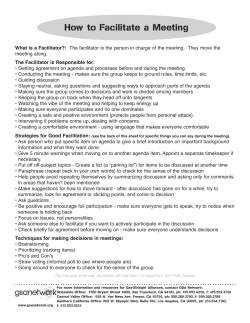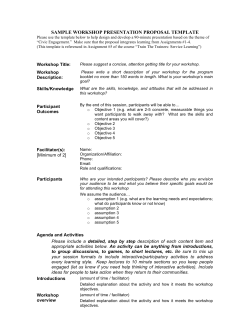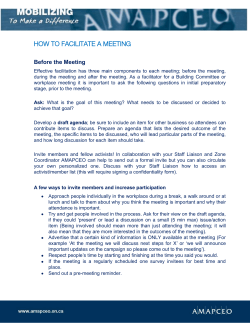
F G OCUS
FOCUS GROUPS A GUIDE TO LEARNING THE NEEDS OF THOSE WE SERVE OFFICE OF QUALITY IMPROVEMENT Focus Groups A Guide to Learning the Needs of Those We Serve The purpose of this document is to provide an overview of the focus group, a useful tool for learning more about the needs, preferences or concerns of those we serve. This discussion of focus group characteristics as well as strengths and limitations is intended to help you determine whether the focus group methodology will be useful for your purposes. Version 2.0, Revised 03.07 Copyright © 2007 University of Wisconsin System Board of Regents For additional information contact: Office of Quality Improvement Room 199 Bascom Hall, 500 Lincoln Drive Madison, WI 53706-1380 608-262-6843 FAX: 608-262-9330 quality@oqi.wisc.edu http://www.wisc.edu/improve FOCUS GROUP GUIDE Introduction In a continuous improvement environment, we strive to understand and meet the needs of our “customers” - those who use and benefit from our products and services. In this never-ending process, these primary stakeholders are often our best source of information about their own needs. Interviewing customers in groups has proven to be an effective way of gathering in-depth information about their needs. These group interviews, structured to feed customer needs into our improvement efforts, are called “focus groups”. Focus groups are used increasingly in higher education as a form of institutional research to identify needs, test solutions, explore how a group perceives a problem or help in designing surveys for wider distribution. Focus groups can be an important component of the ongoing customer communication which is at the core of any great organization. Definition The focus group consists of six to twelve individuals who share a common interest in the process we are improving. They are interviewed by a moderator to learn more about their needs. Well-run focus groups uncover real feelings and issues and provide richer and more profound information than personal interviews or surveys, because the dynamics of a group lead to more developed answers than any individual customer might supply on her/his own. Focus groups also provide the additional non-verbal information (excitement, doubt, stress) that surveys cannot. Focus groups are generally not appropriate tools for evaluating a program or effort. The small number of participants in a focus group is not usually a statistically defensible sample for evaluation. Focus groups are also not appropriate for "go/no go" decisions or making statistical projections. Focus groups are ideal, however, for identifying needs and are valuable precursors for more quantifiable market research. For example a focus group might identify issues that should be explored further through surveys of a larger, more representative sample. Like other qualitative research, focus groups help us understand causality—why people behave as they do. “Knowing why helps us see how,”—how to design, re-design, refine our offerings, services, products so they will be accepted. Focus groups help us change how we think by becoming more externally focused. “As insiders, we know the signals we are trying to send. But inevitably, the signal sent seldom equals the signal received…” (Meridian Business Resources & Consulting, Inc., 1999) Figure 1 is a summary of focus group advantages and limitations. 3 FOCUS GROUP GUIDE Advantages Limitations 1. Focus groups can produce valuable information that is not likely to come from a personal interview or a survey. 1. The small size of a focus group does not allow statistically significant generalization of responses to a larger population. 2. One focus group meeting uses fewer resources (time and money) than multiple personal interviews or large surveys that fail to ask the important questions. 2. Since focus group members usually attend the meeting voluntarily, we might wonder how they differ from the larger population. 3. Responses can be clarified and expanded upon with probing follow-up questions. 4. Non-verbal responses can be recorded and interpreted. 5. Group members can react to and build upon each other’s responses to produce information or ideas that they might not think of on their own. 3. Focus group members may be difficult to recruit. 4. Open-ended responses may be difficult to group into categories. 5. Opinions presented by assertive focus group members may overwhelm ideas held by the rest of the group. 6. Focus groups can be a natural forum for new ideas. Figure 1. Focus group advantages and limitations Requirements for Success Although many factors interact to create successful focus groups, several are of particular importance. We suggest a clear sense of purpose, an experienced facilitator, and follow-up after the focus group. Veteran focus group facilitators emphasize the importance of knowing the purpose of convening the focus group and how the resulting information will be used, before the groups are conducted. Those who will use the data should be aware of its limitations. Once the purpose is clear, a facilitator is identified. The facilitator should be a neutral third party with experience in group facilitation and needs to be skilled at 4 FOCUS GROUP GUIDE probing participants’ answers. Facilitators can assist with pre-planning activities, such as designing the specific questions to be asked. This assistance early in the process can greatly increase the productivity of the focus group. Figure 2 summarizes characteristics of effective facilitators. Effective focus group facilitators: 1. Are comfortable with the content of the questions asked. 2. Skillfully probe participants’ answers and comments to identify underlying beliefs, reasoning, and experience. 3. React in real time to the dynamics of a live group and nurture it into focusing productively on the topic of interest. 4. Are compatible with the group to be interviewed. 5. Are impartial and do not have a reporting relationship with those being interviewed. 6. Are insightful and genuinely interested in hearing other people’s thoughts and feelings. Figure 2. Characteristics of effective focus group facilitators As a practical matter, those who hold focus groups need to be prepared for the results. It is not uncommon for focus groups to bring up negative issues or indicate that needs are not being met. Sometimes a sponsoring group will decide to ignore focus group data when it conflicts with existing beliefs. Instead, when a focus group does uncover such information, the next step should be validation with a larger group through surveys or interviews with a representative sample. When to Avoid the Focus Group When the goal is increased understanding, problem-identification, planning for programs, survey development, and improvement of program implementation, focus groups may be the right choice to elicit information. But focus groups are not always the best method. David Morgan in The Focus Group Guidebook (1998) provides checklists to help identify when focus groups are and are not a good choice. Morgan suggests that focus groups should be avoided when: • • • • • Your goals are something other than research—such as selling, educating, negotiating, or decision-making You cannot hold a focused discussion due to either the breadth of your topic or the size of your group You will not carry on meaningful discussions in the groups you bring together Your driving motivation is to save time and money You need strong predictions about how people will behave 5 FOCUS • • • • • • GROUP GUIDE Asking to hear from people will imply commitments to them that you cannot keep You would be bringing together participants who are not comfortable with each other Your topic is something that the participants are not really capable or willing to talk about You need statistical data Your topic will create serious invasions of privacy Your topic will create unacceptable levels of stress (p. 98). Types of Focus Groups Focus groups may be exploratory or confirmatory or a combination. Exploratory focus groups: • Explore how a group perceives a problem • Use the power of group thinking to brainstorm potential solutions • Identify areas of further investigation or action • Help design surveys for wide distribution • Help interpret unclear or conflicting survey responses • Tend to use open-ended questions to elicit participation Confirmatory focus groups: • Assess solutions already enacted • Seek opinions on proposed efforts • Confirm and expand results from a survey or other data collected • Tend to use closed-ended questions to pinpoint responses Focus Group Steps 1. State the Objectives The questions to be asked are quite dependent on the purpose and how results will be used. Defining the problem determines much of the focus group agenda and interview process. A clear statement of the kind of information that is desired and from whom it should be obtained is the basis for designing a successful focus group. 2. Identify the Sample The sample is a list of people drawn from the group from which information is needed. It may be the entire group, a random sample of the entire group, or it may be a readily available list of people—a convenience sample. 3. Identify a Facilitator The facilitator’s job is to interview the focus group according to a given agenda, and to probe answers by asking appropriate follow-up questions. The facilitator must also strive to maintain an environment in which 6 FOCUS GROUP GUIDE participants feel comfortable about openly expressing their thoughts. A skilled facilitator constantly monitors group dynamics that may be affecting responses. 4. Create and Pre-test the Interview Questions There is no “right” set of questions, just the set which is right for the purpose at hand. In general, exploratory focus groups call for more open-ended questions (“What do you like best about ice cream? Why?”), while confirmatory focus groups call for more closed-ended questions (“Do you like chocolate or vanilla ice cream better? Why?”). However, all focus groups will contain some combination of exploratory and confirmatory questions, beginning with the more general (open-ended) and transitioning to those which are more specific (closed-ended). Most interviews consist of fewer than 12 initial questions, with four or five questions being the average number of questions in focus groups on this campus. The number of questions depends on how time-consuming each topic is estimated to be and the facilitator’s skill. Adequate time should be left for meaningful follow-up questioning, which may take up as much time or more as the original questions. Try not to attract attention to how you expect participants to discuss the topic when you phrase the question. Take care to ensure that questions aren’t worded in a way that the group is led to an obvious, socially acceptable response. The goal is to hear how participants naturally judge your process, service, or product. For open-ended questions, ask how they “feel” or what they “think” about the topic of interest, and let the moderator probe along whatever measures the participants supply. For closed-ended questions, avoid yes/no questions because they stifle discussion. If necessary, provide alternative choices, but be sure the moderator follows up by asking why participants made a particular choice. Use simple wording everybody in the group can understand. Pre-test the questions on several prospective focus group members and revise if necessary, so you can be assured that participants will understand the questions. 5. Recruit Group Members Contact members of the sample and inform them of the general purpose and topics of discussion, the time and location of the meeting, and the method you will use to record their responses. Some groups on campus have had good success with recruiting groups by offering modest incentives such as coffee mugs, CDs, bookstore gift certificates, and the like. And providing food usually works well! Eight to twelve participants is an ideal number. Try to recruit at least 10, since a few may cancel at the last minute. 7 FOCUS GROUP GUIDE A few days before the focus group is to meet, send the participants a note or call them to reconfirm their participation. If you think participants will need time to prepare answers, send them copies of the interview questions. If you will be tape recording the session, inform them of this in writing. 6. Conduct the Focus Group(s) It is common practice to convene more than one focus group for a given topic. With three focus group sessions (different participants) focusing on the same questions, patterns will typically emerge. Record all responses, including the follow-up questions. Whenever possible, non-verbal participation should be recorded as well. Professional marketing firms often employ observers to record non-verbal responses. The moderator should not be responsible for committing everything said to paper, and those who are doing the recording (either written or audio taping) should remain as unobtrusive as possible. Seating arrangements affect the general environment of the focus group. Amply-spaced seating at a round table helps participants feel they are part of a friendly, problem-solving mission, in which their individual experiences and opinions are valued. 7. Analyze the Results Sometimes those analyzing the findings are asked only to summarize what the groups said and sometimes they are asked to also make recommendations for action. In either case, the expectation needs to be made clear. Analysis is always a process of coding and sorting results into categories and looking for patterns and trends. In the scissors-and-tape method, the transcript pages are cut up so each response is a separate strip of paper. The strips are then reorganized by themes or categories. This is a traditional and respectable way to synthesize and analyze results. Computer software is a great help in indexing and cross-referencing responses. But a human being still has to code each response so the software can sort it. Many times the results will not seem like an answer to the original question until the entire focus group process is presented on paper, from the original problem statement to interpretation of the results. In preparing the findings report, the researcher seeks primarily to identify evidence that repeats or that raises fundamental questions that beg further inquiry. 8. Capture Lessons Learned and Share Results Document what you discovered, clearly stating on paper what you learned about the program, product, or service from the point of view of those you serve. Did the focus group confirm your assumptions? Did it provide you with information about new problems? 8 FOCUS GROUP GUIDE Evaluate your focus group interview process. What will you change the next time around? What went well or poorly? Finally, share your document with focus group participants and other members of your organization. It is customary and courteous to provide feedback to the individuals who served on the focus groups, both acknowledging their participation and indicating results and how the data will be used. Audio Recording Since documentation of what is said during focus groups is the primary means of analyzing the results, focus group organizers frequently wonder whether or not they should arrange to record their interview sessions. The answer to this question depends upon the purpose of the focus group, who is participating, and what will be done with the information gathered. Figure 3 lists some factors to consider. Potential Benefits 1) Accurately captures everything that was said 2) Provides a permanent record - which may be useful if subsequent analysis is required 3) May limit speculation and half-truths if attendees know their words are being recorded 4) Communicates to participants that what they are saying is important and valued Potential Disadvantages 1) May stifle conversations initially, until attendees forget they are being recorded 2) May be a distraction - especially if there is a need to test the volume or "fiddle" with the recorder during the session 3) Risk that recording may be used out of context or for other purposes 4) Requires consent from attendees 5) May add more formality than is intended Figure 3. Potential benefits and disadvantages of audio recording focus groups The alternative to audio taping focus groups is for an assigned note taker to capture key points during the meeting. If participants are particularly sensitive to remaining anonymous, the note taker can review and verify the key points at the end of the session. Selectively using audio or video recording for gathering only specific information, and detailing to participants exactly how this information will be used, is another option. Whether the focus group discussion will be recorded on tape or on paper, people are often hesitant to speak if they think their exact words will be captured or that they can be identified. Assuring participants of anonymity in the final report can lead to more open responses, as will promising them that they will receive a copy of the results. 9 FOCUS GROUP GUIDE Campus Focus Group Examples Following is a list of some focus groups convened on the UW-Madison campus. These examples indicate the great variety of questions and purposes for which focus groups might be used. 1. The School of Business Evening Masters Degree As this program neared the end of its first year of implementation, focus groups of students were held to identify issues of importance to them. These results were used to create an annual feedback and satisfaction instrument. Examples of questions asked included, “What are the current strengths of the Evening MBA Program? What should be improved in the Evening MBA program? What are your expectations for this program? What should a graduate of the program know, understand and be able to do? What could the Evening MBA Program improve in the following areas: support services (i.e. library, career center, evening MBA program office); social activities (involvement you’d like to have); technology (help/assistance); teaching/learning (learning experience, text books, time commitment, etc.)?” 2. Safety Task Force of FP&M Members of the Safety Task Force of Facilities, Planning & Management requested and received training on conducting focus groups. Those trained worked in groups of two to facilitate 13 focus groups on safety issues in FP&M shops including sheet metal, mason, Charter Street Heating Plant, electric, paint, machine shop, garage, steam fitter, carpenter, maintenance mechanic, truck service and shop supervisors. One of the questions asked was, “What are the most effective ways for you to receive safety-related information?” 3. Department of Zoology Four focus groups were held to better understand how students were experiencing the undergraduate program. The data were used to design a long-term study of graduates one, three and five years after graduation. Examples of questions included, “What does the department do well? What could it do better? How have your critical thinking skills improved through Zoology courses? Describe the best teaching/learning experience in a Zoology course and what benefit did you gain from the experience?” 4. Medical School The Medical School conducted employee focus groups to better-understand issues of organizational climate. Examples of question asked include, “What interactions with faculty-staff-students have you enjoyed the most? What interactions with faculty-staff-students have you enjoyed the least? Do services for students provide adequate support to optimize your success? 10 FOCUS GROUP GUIDE What concern about academic climate would you most like to change in the coming year? What are your suggestions for improvement?” 5. Greek Life in the 21st Century Participants included students, staff, faculty and alumni involved with or concerned about fraternities and sororities. Topics included governance, communication, alcohol policy and leadership development. 6. University Industry Relations UIR and WARF used a focus group to gain ideas for encouraging faculty to disclose inventions for potential patenting. Numerous faculty who have successfully patented inventions participated. Before the focus group, they completed a survey regarding factors that encourage or discourage disclosure, results of which framed the questions. 7. Nancy Denney House Three focus groups were conducted to inform the planning process for the Nancy Denney House, a residence for single parent undergraduates at UWMadison and their children. 8. Recruitment and Retention of Minority Faculty and Staff Fourteen focus groups were held of faculty, academic staff and classified staff to identify barriers to recruitment and retention as well as specific strategies to address them. These focus groups were held at the request of the Human Resources/ Diversity subcommittee of New Directions, the group responsible for writing the university’s self study report for the North Central Association (NCA) reaccreditation exercise. 9. Robert Wood Johnson (RWJ) Project A focus group was held of campus bar and liquor store owners, UW administrators, Wisconsin Union personnel, UW students, and the Madison Police Department. Goals were to identify areas of common concern and identify joint approaches to curbing problem drinking, barriers to solving the problem of binge drinking and participants’ stake in limiting binge drinking. 11 FOCUS GROUP GUIDE References Meridian Business Resources & Consulting, Inc. (1999). Once more: If the results are not projectable, why do focus groups? Available: http://www.bestprax.com/whydo.htm/. Morgan, David L. (1998). The focus group guidebook. Thousand Oaks, CA: SAGE Publications. Office of Quality Improvement (1998). How to Conduct Focus Groups. University of Wisconsin-Madison. Topor, Robert. [no date].The Complete guide to focus group marketing research for higher education. Mt. View, CA: Educational Catalyst Publications. Available: http://www.marketinged.com/library/books.html#focusgr/ 12
© Copyright 2025





















